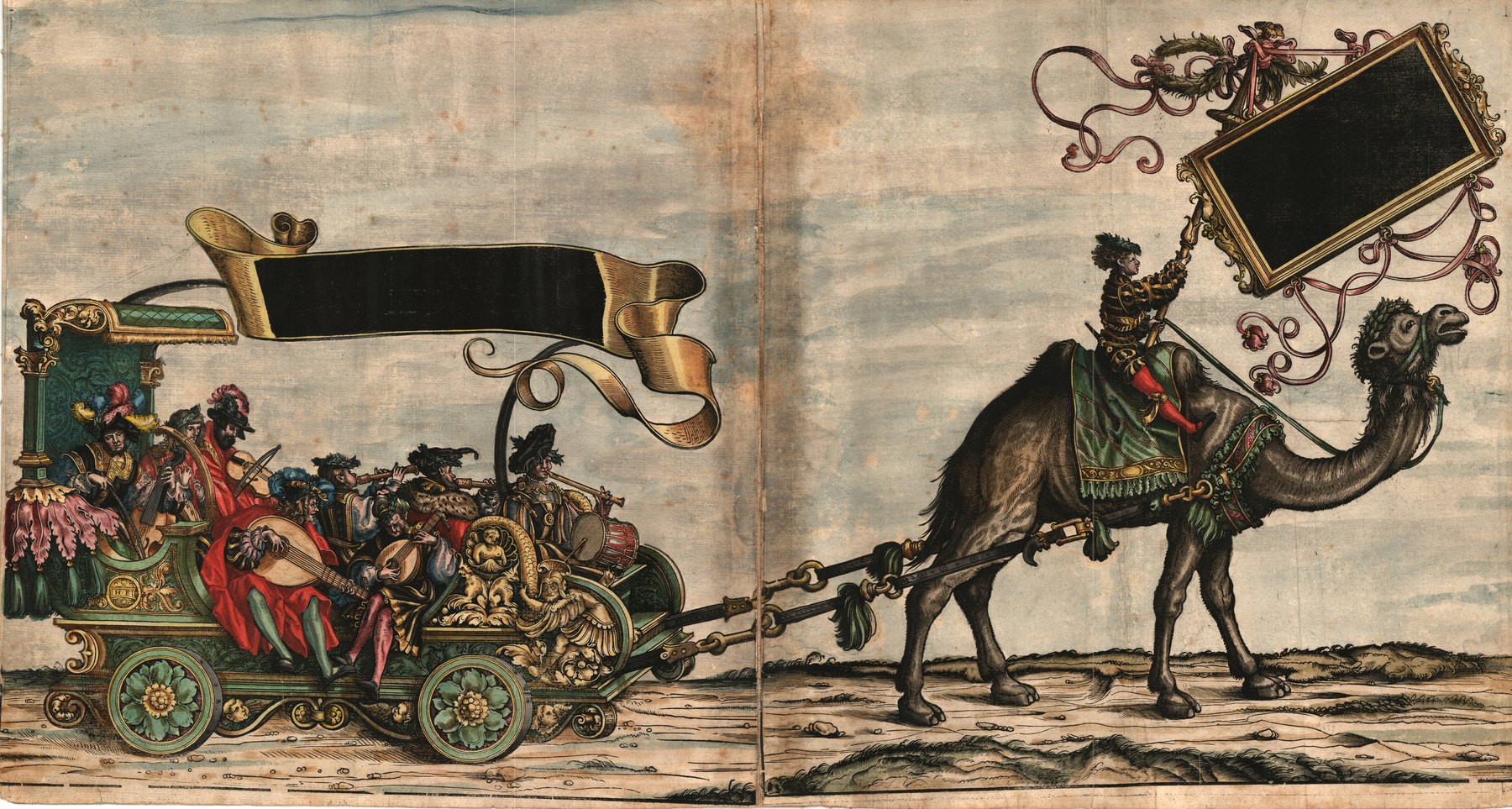“Musica süeß Meledey”: Instrumental Ensembles
Finally, in the Triumphzug, there is a fourth musician carriage, “Music: sweet melody” (“Musica süeß Meledey”) (» Abb. Triumphzug Süße Melodie), whose “Maister” Maximilian had not yet determined. A total of eight musicians are depicted, with their instrumentation precisely specified:
„ain tämerlin, ain quintern, ain große laüten, ain Rÿbeben, ain Fydel, ain klain Raůschpfeiffen, ain harpfen, ain große Raůschpfeiffen.“ (a tämerlin, a quintern, a large lute, a Rÿbeben, a fiddle, a small rauschpfeife, a harp, a large rauschpfeife)[31]
While these specifications were apparently clear to the illustrators, the exact identification of the instruments today is more difficult. The “tämerlin” is a one-handed flute and drum, a type of one-man dance music ensemble, as depicted several times in Freydal. “Quintern” and “large lute” refer to a duo of two differently sized lutes. Next are a viola da gamba, a fiddle or proto-violin, and a harp. The two rauschpfeifen are woodwind instruments with reeds enclosed in a wind cap, similar to the crumhorn. All the named instruments likely did not play together in this combination; rather, different individual ensembles are depicted here. The incompatibility is already evident in the different volume levels of the instruments, reflecting the late medieval distinction between “bas” (soft) and “haut” (loud). This also signifies a differentiation of performance venues, with (soft) string instruments being played in the chamber for a few listeners, versus (loud) wind instruments being played outdoors or in a large hall.
[31] So the wording in the formulation of the iconographic program in » A-Wn Ms. 2835, fol. 8v.
[1] Zum Triumphzug, seinen unterschiedlichen Versionen und der komplexen Entstehungsgeschichte informiert Appuhn 1979 und Michel/Sternath 2012; zur Bedeutung für Maximilian Müller 1982; zum Verhältnis zwischen Abbildung und Realität Polk 1992; das Zitat stammt aus der frühesten erhaltenen Formulierung des ikonographischen Programms des Triumphzugs 1512 in » A-Wn Cod. 2835, fol. 3v.
[2] Koczirz 1930/31, 531 f.
[4] Nedden 1932/33, 27 (Zitat aus den Augsburger Baumeisterbüchern von 1491, den Kassenbüchern des Rats über Ein- und Ausgaben).
[5] Vgl. Simonsfeld 1895, 267 f.
[6] Vgl. Strohm 2009, 98.
[7] Zitiert nach Waldner 1897/98, 2.
[8] Treitzsaurwein 1775, 78.
[9] Vgl. Schwindt 2012.
[10] Sie erhält im Juni 1520 bei der Auflösung der Hofkapelle nach dem Tode von Maximilian die hohe Summe von 50 Gulden „zu Irer vnderhaltung vnd Zerung“; Koczirz 1930/31, 535.
[11] Wie beispielsweise „Hannsen pfeiffer vnnd matheusen Trumelschlacher“, die 1491 ausdrücklich für ihre Dienste „bei Tanz“ an der Fasnacht bezahlt werden; Waldner, 1897/98, 52.
[12] Appuhn 1979, 172 f.
[13] Für eine Zusammenstellung der musikrelevanten Abbildungen siehe Henning 1987, 69–94
[15] Vgl. Gombosi 1932/33; Heinzer 1999, 92 ff.
[17] Vgl. Kirnbauer 2005.
[18] Vgl. Kirnbauer 2003, 243–248 (dort auch zum Folgenden).
[20] Laut Zahlungen in den Augsburger (D-As) Baumeisterbüchern Nr. 103 (1509), fol. 24v, und Nr. 104 (1510), fol. 28; freundliche Mitteilung von Keith Polk.
[21] Vgl. Jahn 1925, 10 ff., und Kirnbauer 2000, 25 ff.
[22] Kirnbauer 1992, 131.
[23] Nedden 1932/33, 31.
[24] Vgl. Polk 1989a; Polk 1989b.
[25] Hintermaier 1993, 38.
[26] Vgl. Brief von Paul Hofhaimer an Joachim Vadian am 14. Mai 1524; Moser 1966, 56.
[29] Nowak 1932, 84.
[30] Praetorius 1619, 148.
[31] So der Wortlaut in der Formulierung des ikonographischen Programms in » A-Wn Ms. 2835, fol. 8v.
[32] Vgl. Welker 1992, 189–194.
[33] Aich 1515, Titelblatt des Tenor-Stimmbuchs; zur Datierung siehe Schwindt 2008, 117 ff.
[34] Vgl. Bernoulli/Moser 1930, v–vii; McDonald/Raninen 2018.
[35] Vgl. Brinzing 1998, 137–154; Filocamo 2009.
[37] » A-Wn, Mus. Hs. 41950; Faksimile und Beschreibung in Kirnbauer 2003. Lautentabulaturen der nächsten Generation aus dem süddeutschen Sprachraum beschreibt » H. Lautenisten und Lautenspiel (Kateryna Schöning).
[38] Gerle 1533, fol. IIv.
[39] Vgl. Moser 1966, 26 und 182, Fußnote 35.
[40] Vgl. Moser 1966, 137–140; Radulescu 1978, 66 f.; siehe auch » C. Orgeln und Orgelmusik.
Empfohlene Zitierweise:
Martin Kirnbauer: „Instrumentalkünstler am Hof Maximilians I.“, in: Musikleben des Spätmittelalters in der Region Österreich <https://musical-life.net/essays/instrumentalkunstler-am-hof-maximilians-i> (2016).
